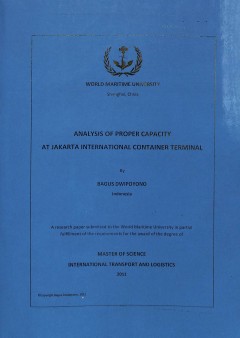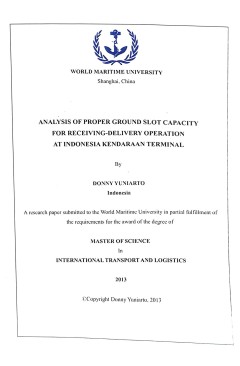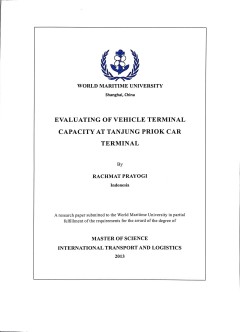Ditapis dengan

Analysis of proper capacity at Jakarta International Container Terminal
As a facility with high capital investment, container terminal tends to be operated with maximum capacity by using high utilization of facilities and equipment rather than a proper throughput. However, a high utilization is leading to the ships waiting time and as consequence lowering the service level. Therefore a study is needed to determine the proper capacity by considering the interest of …
- Edisi
- -
- ISBN/ISSN
- -
- Deskripsi Fisik
- xiii, 100 p., ; illus : 30 cm ; bibliography
- Judul Seri
- -
- No. Panggil
- TD PO DWI a C.1

Optimal stack layout in a sea container terminal with automated lifting vehicles
Container terminal performance is largely determined by its design decisions, which include the number and type of quay cranes, stack cranes, transport vehicles, vehicle travel path and stack layout.We investigate the orientation of the stack layout (parallel or perpendicular to the quayside) on the throughput time performance of the terminals. Previous studies in this area typically use deter…
- Edisi
- 2017
- ISBN/ISSN
- 1366-588X
- Deskripsi Fisik
- 20P
- Judul Seri
- International Journal of Production Research
- No. Panggil
- ATC LO GUP o

A comparison of analytical methods and simulation for container terminal plan…
Queuing models and simulation are two primary methods applied to container terminal planning. Queuing models tend to result in underestimated outcomes due to ships and berths not being classified by size and length. This paper classified both ships and berths using actual data and then compared the resultant differences of the scenarios with and without classification with the simulation. The c…
- Edisi
- Vol. 24, No. 3, pp. 200-209 (2007)
- ISBN/ISSN
- -
- Deskripsi Fisik
- 11 p.
- Judul Seri
- Journal of the Chinese Institute of Industrial Engineers
- No. Panggil
- ATC LO HUA a

Analysis Of Proper Ground Slot Capacity for Receiving-Delivery Operation At I…
Indonesia Kendaraan Terminal (1KT) is dedicated terminal to handling vehicle cargo, currently, IKT has one entrance gate and 14 ground slots for trucks. It causes a queue at certain hours because of the trucks coming at the same time. Therefore a study is needed to determine the proper capacity for Receiving and delivery operation by considering the needed the terminal management who desire to …
- Edisi
- -
- ISBN/ISSN
- -
- Deskripsi Fisik
- ix, 83 p., : illus : table : graphic : 29 cm
- Judul Seri
- -
- No. Panggil
- TD PO YUN a

Evaluating Of Vehicle terminal Capacity At Tanjung Priok Car Terminal
Terminal capacity is to be considered by the management to keep terminal services efficiently. Lack of terminal capacity will leverage congestion in the port and in turn will give bad influence for international trading growth. Considering cargo forecasting at Tanjung Priok Car Terminal (TPT), they still have an idle capacity of berth but having a critical point in the yard capacity. Proper thr…
- Edisi
- -
- ISBN/ISSN
- -
- Deskripsi Fisik
- ix, 88 p., : table : graphic : 29 cm
- Judul Seri
- -
- No. Panggil
- TD PO PRA e
 Karya Umum
Karya Umum  Filsafat
Filsafat  Agama
Agama  Ilmu-ilmu Sosial
Ilmu-ilmu Sosial  Bahasa
Bahasa  Ilmu-ilmu Murni
Ilmu-ilmu Murni  Ilmu-ilmu Terapan
Ilmu-ilmu Terapan  Kesenian, Hiburan, dan Olahraga
Kesenian, Hiburan, dan Olahraga  Kesusastraan
Kesusastraan  Geografi dan Sejarah
Geografi dan Sejarah